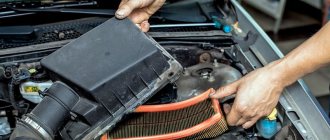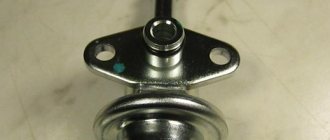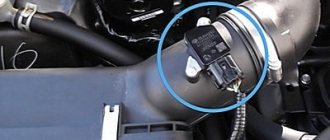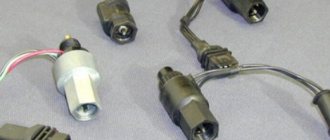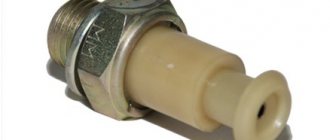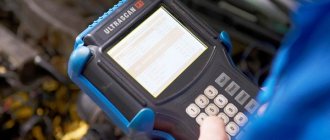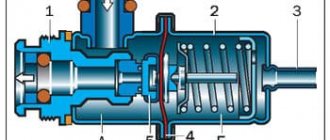Symptoms of DBP malfunction
If the absolute pressure sensor (also called MAP sensor, Manifold Absolute Pressure) fails completely or partially, the failure appears externally in the following situations:
- High fuel consumption. This is due to the fact that the sensor transmits incorrect data on the air pressure in the intake manifold to the ECU, and accordingly, the control unit issues a command to supply more fuel than necessary.
- Reduced engine power. This manifests itself in poor acceleration and insufficient traction when driving the car uphill and/or when loaded.
- There is a persistent smell of gasoline in the throttle valve area. This is due to the fact that it is constantly overflowing.
- Unstable idle speed. Their value either falls or rises without pressing the accelerator pedal.
- Engine “dips” during transient conditions, in particular, when changing gears, starting the car, or changing the throttle.
- Problems starting the engine. Moreover, both “hot” and “cold”.
- Formation of errors in the memory of the electronic control unit with codes p0105, p0106, p0107, p0108 and p0109.
Most of the troubleshooting symptoms described are general and can be caused by other reasons. Therefore, it is always necessary to perform comprehensive diagnostics, and you need to start first by scanning for errors in the ECU.
Diagnostic measures
How to check the absolute pressure sensor and determine that it is working:
- first, connect an adapter for a pressure gauge to the vacuum hose connecting the device and the inlet manifold;
- The power unit is allowed to idle for some time. If there is a vacuum in the manifold - readings below 529 mm, you need to make sure that there is no damage to the hose, there are no defects in the sensor diaphragm;
- Having received the data from the pressure gauge, it is disconnected and a vacuum pump is installed in its place. A rarefied state is created (55–56 mm), after which pumping stops. If the state is held for about thirty seconds, then the sensor is working properly, and the problems with the car lie in something else. Otherwise, the faulty device must be replaced.
If the device is digital, diagnostics occurs somewhat differently:
- the tester is switched to voltmeter mode, a wire installed on the output contact of the device being diagnosed is connected to it;
- the power plant starts. If the voltage is maintained at 2.5 V, then the sensor is working, but if it deviates to one side or the other, it requires replacement;
- in tachometer mode and with the vacuum hose disconnected, the positive probe is connected to the signal terminal, and the negative probe is connected to ground. If the cause of the malfunction is not in the DBP, then the tachometer will show a value of 4400–4900 rpm;
- After connecting the vacuum pump, you can determine whether there are changes in the readings obtained by the tachometer. If they are, then you should consider replacing them.
general information
When the engine is running under load, the intake vacuum drops as the throttle opens wide. The engine draws in more air, which requires more fuel to maintain the air-fuel ratio.
In fact, when the ECU reads a heavy load signal from the DBP, it usually causes the fuel mixture to be a little richer than normal so the engine can produce more power. At the same time, the control unit slightly changes the ignition timing (IDA) to prevent detonation, which can damage the engine and reduce performance.
When conditions change and the vehicle is driven under light load, coasting or decelerating, less power is required from the engine. The throttle valve is open slightly or may be closed, causing the intake vacuum to increase.
The MAP sensor detects this. The ECU leans the fuel mixture and changes the ignition timing to reduce fuel consumption.
How to check DBP yourself
To be completely honest, it is worth noting that the sensor has a mega reliable design and very rarely fails. But, unfortunately, I cannot say such flattering words about his wiring. At least on the Chevrolet Lacetti.
I don’t know where and from whom the idea came up to wire such an important sensor in this way. The fact is that two of the two sensor power wires have pins in their path, which over time can drain quite a bit of blood from the poor car owner.
Therefore, when checking DBP, it is necessary to pay more attention to the wiring and not to the sensor itself.
How can you check DBP?
There are many testing methods, but we only need the simplest ones and without special equipment. Right? I think yes!
Therefore, there are only two options left:
- using computer diagnostics
- using a multimeter
How to check the operation of the absolute pressure sensor
Toyota Town Ace Noah
1 answer
The best
. To test the sensor, which is an analog type, take an adapter and connect it to the vacuum hose between the intake manifold and the pressure sensor. A pressure gauge is connected to the adapter.
Pressure sensor2. We start the engine and let it idle for a while. If you note that the vacuum in the collector does not exceed 529 mmHg. Art., you should very carefully check the condition of the vacuum hose. Make sure there is no damage or kinks that could cause significant air loss. It is also important how correctly the camshaft drive belt is installed. Another reason why the vacuum level indicator will decrease significantly is various defects in the sensor diaphragm (they can be either factory-made or the result of improper operation).
3. Having received all the necessary indicators of the pressure gauge, we can replace it with a vacuum pump. With its help, it is necessary to raise the vacuum level to 55-560 mm Hg. Art. and immediately stop pumping. If the sensor is working properly, then it will display this level of vacuum for at least 25-30 seconds. Otherwise, the sensor will have to be replaced.
4. If you need to check the absolute pressure sensor, which is of the digital type, you will need to use a tester, having first switched it to measuring voltage.
5. Turn on the ignition in the car. We are looking for power and ground contacts. We need to connect a wire to our voltmeter that connects to the signal contact of the sensor being tested. If it works normally, then the voltage relative to ground will be on average within 2.5 V. If there are any malfunctions, it may be higher or lower than this indicator.
6. Switch the tester to work in tachometer mode. We need to disconnect the vacuum hose from the pressure sensor. Connect the positive terminal of the tachometer to the signal wire, and the negative terminal to the ground wire. During normal operation, the tachometer will show a result of 4400-4850 rpm.
7. Next, you will again need a vacuum pump, which must be connected to the pressure sensor hose. Try to see what the tachometer reading will be if the pump constantly changes the vacuum in the sensor. During normal operation of the sensor, the vacuum will be stable, as well as the indicators of the device used.
8. After turning off the vacuum pump, the tachometer indicator should stop between 4400 and 4900 rpm. If the reading of your pressure sensor deviates from the indicated figures, it is faulty.
Having figured out the reason for the poor performance of the car, you need to begin eliminating it. If the fault is hidden in some parts that complement the sensor, then the device itself can be left. However, if the check directly indicated its incorrect operation, we proceed to replacing the absolute pressure sensor.
Is it possible to repair the absolute pressure sensor and how to do it? Absolute pressure sensor Well, the sensor is broken and what should you do about it? Of course, you can try to repair it, but immediately note that its design is not designed for such manipulations. You will have to carry out any actions of this kind at your own peril and risk, which, of course, does not stop many. The fact is that the cost of a new sensor today is a fairly large sum of money, which fluctuates around 1 thousand hryvnia, so not everyone is able to shell out that kind of money for the smallest device in a car. If the problem is not with the absolute pressure sensor itself, then you can act more boldly, since replacing various connections can be done without fear.
For those who are really not ready to purchase a new device and are still ready to repair the absolute pressure sensor, we will share the experience of one of the amateur motorists. So, you need to start with the fact that the sensor displaying absolute pressure is removed from the car. Next, you need to carry out the following manipulations with it:
1. Using a knife or other sharp object, carefully remove the cover from the sensor and check where exactly the sensor malfunction is hidden.
2. If there is rust or other contaminants on the contacts of the device, they must be thoroughly and carefully cleaned. Also, do not forget to check how well all the wires are connected; perhaps the cause of the malfunction lies there. After cleaning, do not forget to dry it.
3. After a good cleaning, it is recommended to completely fill the sensor with silicone sealant and leave it to dry on the batteries.
4. After at least a day, we can take our sensor out of the battery and put the cover back on it. Its joints can also be sealed using the same sealant.
5. He goes to the garage to his car and installs the absolute pressure sensor in its rightful place. We try to start the car and check the effectiveness of our work. If the car starts up smoothly and quickly, we can say that everything worked out for us. Otherwise, any additional recommendations will be useless, and you will have to go to the store to buy a new device.
How to check DBP
This article will talk about how to check the DBP (absolute pressure sensor) and the health of its circuits. I will also post a video test at the end of the article.
The absolute pressure sensor is the main sensor in the engine management system.
All processes in the engine depend on the mass of air entering the combustion chambers. That is why the only engine control lever in the driver’s hands (or rather feet) is the accelerator pedal.
What does the driver’s right foot do? Right! To supply air to the engine. That is, with the gas pedal we simply regulate the air supply. That's all.
At this stage, the human influence on the operation of the engine ends and everything passes into the “hands” of the engine control system. And the primary task of this system is to calculate the mass of air that we launched into the intake manifold. All subsequent actions taken by the ECU to control the engine depend on this calculation.
It is for these purposes that the absolute pressure sensor in the intake manifold is used. It measures the pressure in the manifold and the “brains” use this data to calculate the mass of air passing through the intake manifold into the engine.
But since it is the mass of air that is important, and not the volume, a temperature sensor of the air entering the cylinders must be installed in conjunction with the DBP. This is necessary because warm and cold air have different densities, and, as is known, the mass of a body or gas depends on density.
But we looked at the air temperature sensor in another article, and in this one we will focus exclusively on the absolute pressure sensor.
This is how everything is described in literature and manuals. But my opinion looks a little different. It is not intended to calculate air mass (this is calculated by software), but to determine the load on the engine. I will write about this below.
From all of the above, we can conclude that DBP is a mega important sensor in the engine control system and sometimes requires diagnostics, like all other sensors.
How to check an absolute pressure sensor with a multimeter
Checking DBP with a multimeter consists of several parts:
- checking the resistance of the wires from the control unit to the sensor
- checking the voltage on the sensor
- checking the voltage at the sensor in idle mode
First of all, you need to ring three wires from the DBP to the ECU. In 80% of cases, it is at this stage that the problem is discovered.
I didn’t take photos of the process, since I filmed everything on video, in which you can see it all.
I will simply describe the essence of the test.
Disconnect the negative terminal of the battery.
Next, you need to remove the block from the DBP and from the ECU. You can see how to do this in the video, or in the article Lacetti's problem of three masses
There are three wires from the ECU block to the DBP block that we need to check:
- 1 - mass (A)
- 2 - signal (B)
- 3 - power supply +5 V (C)
To check the DBP wiring, you need to set the ohmmeter to resistance measurement mode up to 200 Ohms and connect the probes in this order:
- to the 1st contact of the DBP block and to the 13th contact of the ECU block
- to the 2nd contact of the DBP block and to the 75th contact of the ECU block
- to the 3rd contact of DBP and to the 50th contact of the ECU block
In all these cases, the resistance should be minimal, and when pulling the wiring harness with your hands, the resistance should not change. If the reading values change, this means that there is an unreliable contact in the wiring and it is necessary to cut the wiring harness and find the problem area.
If at this stage the problem is not detected, then it is necessary to measure the voltage at the sensor.
To do this, we connect back the ECU block, the DBP block and the battery terminal.
We turn on the ignition, but do not start the engine.
We switch the multimeter to DC voltage measurement mode up to 20 V.
We connect the negative probe of the multimeter to the first contact of the absolute pressure sensor, and the positive probe to the third contact. If the probes do not fit into the connector, then you can use ordinary paper clips, insert them into the connector, and connect our probes to them.
The voltmeter should show a voltage of approximately 4.9 V. This means that power is being supplied to the sensor.
Then we connect the “positive” probe to the second contact, and leave the second probe in the first.
The voltage should be approximately 3.5 - 4 V if you are not in the mountains
Let's start the engine. On a warm engine at idle and with consumers turned off (air conditioning, heated rear window, headlights, etc.), the voltage should be approximately 1 V. When the throttle is opened, the voltage should increase and then decrease.
It is also necessary to check the tube from the sensor to the intake manifold for clogging and condensation. And check the fitting on the manifold for clogging with oil from the crankcase ventilation system
If the tube is blown out, the wiring is intact, power is supplied, but the DBP does not work correctly, or does not work at all, then most likely it is time for it to go to the landfill.
The sensor's response can be checked in another way. To do this, turn on the ignition, connect a voltmeter to the first and second contacts of the DBP, disconnect the sensor tube from the manifold and connect a medical syringe to it. When the syringe piston moves, the sensor should respond to this, which can be seen by the changing voltage on the multimeter.
These are all the simple manipulations that will help you check the DBP and identify problems in its wiring.
Here is a video on how to check DBP
Previous Vehicle Diagnostic Parameter - Throttle Position
Return to the main section Car diagnostics
Design and principle of operation
The DTOZh temperature sensor is a resistor (thermistor) that reacts to the temperature of the antifreeze in the engine cooling system. Information about the resistance of this element is transmitted to the ECU, which decides to change the settings in the engine operation.
The information obtained is used by the ECU to determine the steps of the idle speed regulator to optimally adjust the required volume of the fuel mixture.
The peculiarity of DTOZH is that in the cold its resistance increases, and when heated, on the contrary, it decreases.
So, when reaching 130 degrees Celsius, the resistance parameter is 70 Ohms, and at minus 40 degrees - 100.7 kOhms.
The thermistor is controlled by applying +5 V voltage to it from the controller.
The potential passes through a classical resistor with constant resistance (R).
The antifreeze heating level is calculated based on the voltage drop across the DTOZh with variable R (Ohm). In this case, the drop will be large on a cold engine, and low on a warm engine.
Where is the absolute pressure sensor located?
DBP can be located in several places depending on the make and model of the car. The MAP sensor can be installed on the engine shield, inner fender or intake manifold.
The sensor is connected directly through a hole in the manifold or using a fitting and a hose.
On turbocharged engines, the MAP sensor is most often mounted directly on the intake manifold.
Faulty manifold sensor: signs
Considering that the intake manifold pressure sensor plays an important role in the operation of the vehicle's ECM, sensor malfunctions lead to serious engine malfunctions in all modes.
As a rule, if the DBP fails, the following signs and symptoms can be identified:
• idle speed is high or floating; • under load the speed “jumps”; • the engine is noisy and smokes; • increased level of vibrations; • there is a smell of fuel in the exhaust; • power decreases and consumption increases.
The appearance of these signs clearly indicates the need to check DBP. If the diagnosis reveals a sensor malfunction, the problem is solved by replacing the absolute pressure sensor.
What types of pressure sensors are there?
Depending on the design of the engine, there may be two, three or more sensors that control the supply and air pressure into the system. For example, in engines with a turbine, another sensor may be installed that monitors the compressor pressure. In principle, the design of these devices is identical - they are designed to measure pressure and send data to the electronic engine control unit.
The sensor that interests us measures the so-called absolute pressure, that is, it shows the pressure value not relative to atmospheric pressure, but relative to complete vacuum. Depending on the principle of operation of the device, it can be designed according to two schemes: a device based on a thin film, which reacts to changes in pressure and generates a certain electrical potential transmitted to the ECU; a more accurate and modern sensor design system is micromechanical.
Vehicle absolute pressure sensor
Modern power plants are equipped with electronic control units that allow you to monitor the operation of all systems and receive timely information about their incorrect operation. One of the devices is an absolute pressure sensor, abbreviated as DBP. It helps ensure stable operation of the power unit, and transmits the collected data to the ECU.
In many car models equipped with a similar device, it is not difficult to find - the pressure sensor is located in the intake manifold of the engine. Here he is responsible for obtaining information about pressure changes in the intake tract. Electronics, based on the data received from it, optimizes the composition of the combustible mixture, which is sent to the combustion chamber.
How does an absolute pressure sensor work?
Before checking the absolute air pressure sensor, it is necessary to understand in general terms its structure and operating principle. This will facilitate the verification process itself and the accuracy of the result.
Thus, in the sensor body there is a vacuum chamber with a strain gauge (a resistor that changes its electrical resistance depending on the deformation) and a membrane, which are connected via a bridge connection to the electrical circuit of the car (roughly speaking, to the electronic control unit, ECU). As a result of engine operation, air pressure changes, which is recorded by a membrane and compared with vacuum (hence the name - “absolute” pressure sensor). Information about pressure changes is transmitted to the ECU, on the basis of which the control unit makes a decision on the amount of fuel supplied to form the optimal air-fuel mixture. The full sensor operation cycle looks like this:
- Under the influence of pressure differences, the membrane is deformed.
- The specified deformation of the membrane is recorded by a strain gauge.
- Using a bridge connection, the variable resistance is converted into a variable voltage, which is transmitted to the electronic control unit.
- Based on the information received, the ECU adjusts the amount of fuel supplied to the injectors.
Modern absolute pressure sensors are connected to the ECU using three wires - power, ground and signal wire. Accordingly, the essence of the test often comes down to using a multimeter to check the resistance and voltage on the specified wires under various operating conditions of the engine in general and the sensor in particular. Some MAP sensors have four wires. In addition to the above three wires, they add a fourth, through which information about the air temperature in the intake manifold is transmitted.
In most cars, the absolute pressure sensor is located directly on the intake manifold fitting. On older vehicles, it may be located on flexible air lines and attached to the vehicle body. When tuning a turbocharged engine, the DBP is often located on the air ducts.
If the pressure in the intake manifold is low, then the signal voltage produced by the sensor will also be low, and vice versa, as the pressure increases, the output voltage, transmitted as a signal from the DBP to the ECU, also increases. So, with the damper fully open, that is, at low pressure (approximately 20 kPa, differs for different machines), the signal voltage value will be within 1...1.5 Volts. With the damper closed, that is, at high pressure (about 110 kPa and above), the corresponding voltage value will be 4.6...4.8 Volts.
What is an absolute pressure sensor used for?
The use of various sensors for industrial and other production and non-production purposes is due to the desire to control the execution of various processes, changes in which may affect the performance of mechanisms and the availability of consumer results. One of the most popular are pressure sensors. Their practical significance has made it possible to become widely applicable in almost all areas of human activity where systems and units operating with liquid and gaseous media are encountered. Modern devices of this type involve converting the quantity being measured into an electrical signal for display in understandable values. However, earlier versions had a display in the form of a mechanical dial.
In some cases, the human eye and senses are not capable of determining the state of pipeline systems or the pressures injected into objects. Therefore, the pressure measurement sensor used in various systems becomes an indispensable device. Having at his disposal such a device, based on a silicon, ceramic or piezoresistive sensing element, a person can see the result of a condition, as well as their sudden changes, with his own eyes, without relying solely on intuition and other senses. After all, for example, the pressure in a specialized pipeline (especially if it has cyclic and branched structures) cannot be measured in more efficient ways with an accuracy of the operational values established by the technical requirements. Monitoring the values that are recorded makes it possible to establish its absolute indicator, pumped by pump drives.
What is the absolute pressure sensor responsible for and what does it affect?
Using DBP allows us to understand how different the pressure in the system is from its zero state. At the same time, the ability of modern devices to operate in several modes allows them to control changes in any conditions and parameters of environmental activity. The control area of such sensors depends on the scope of their application:
- Food, chemical industry, etc. The use of DBP allows you to control the parameters of technological processes for processing raw materials and other components, the degree of efficiency of which depends on absolute values.
- Barometers, weather stations and instruments moving in the atmosphere. In this case, high-precision electronic absolute pressure sensors are used and have built-in analog-digital microcircuits with 14-16 output bits.
- Compressor units, pneumatic pumping and hydraulic systems, where the role of instruments helps to calculate pressure changes in difficult conditions, for example, at offshore facilities.
- Roll compensation systems and others, where the DBP installed in the pressure converter allows monitoring during the operation of electrical loading and unloading systems.
- In the energy, gas and oil industries, where level control in sealed and other containers is required, the use of high-precision intelligent sensors makes it possible to monitor operating quantities in order to avoid emergency situations.
In its wide range, the modern electrical engineering company Energopusk has a wide selection of all kinds of devices that measure absolute pressure values in control systems for liquids and gaseous materials. The need for sensors is unconditional, since the response speed of automatic and other control systems that control multiple processes in various industries and consumer production lines depends on them. Depending on your needs, you can select sensors that are suitable for you in terms of the size of the boundaries being measured, the method of attachment, measurement accuracy and other parameters. If necessary, our specialist will be able to help you select the desired device; you can contact him in any convenient way: online, by phone, by email.
Pressure Sensors
Still have questions? ENERGOPUSK specialists will answer your questions: 8-800-700-11-54
(8-18, Mon-Tue)
Checking the DBP sensor
Checking the absolute pressure sensor in the manifold comes down to the fact that you first need to make sure that it is clean, and therefore sensitive to changes in air flow, and then find out its resistance and the output voltage when the engine is running.
Cleaning the absolute pressure sensor
Please note that as a result of its operation, the absolute pressure sensor gradually becomes clogged with dirt, which blocks the normal operation of the membrane, which can cause partial failure of the DBP. Therefore, before checking the sensor, it must be removed and cleaned.
To clean, the sensor must be removed from its mounting location. Depending on the make and model of the vehicle, mounting methods and location will vary. Turbocharged engines typically have two MAP sensors, one in the intake manifold and one on the turbo. Typically the sensor is secured using one or two mounting bolts.
Cleaning the sensor must be done carefully, using special carb cleaners or similar cleaning agents. During the cleaning process, you need to clean its body, as well as the contacts. In this case, it is important not to damage the o-ring, contact elements of the housing and the membrane. You just need to spray a small amount of cleaning product inside and pour it back along with the dirt.
Very often, such simple cleaning already restores the operation of the MAP sensor and there is no need to perform further manipulations. So after cleaning, you can put the air pressure sensor in place and check the operation of the engine. If it doesn’t help, then you should move on to checking your DBP with a tester.
Checking the absolute pressure sensor with a multimeter
To check, find out from the repair manual which wire and contact is responsible for what in a particular sensor, that is, where are the power, ground and signal wires (signal in the case of a four-wire sensor).
To figure out how to check the absolute pressure sensor with a multimeter, you must first make sure that the wiring between the ECU and the sensor itself is intact and does not have a short anywhere, because the accuracy of the result will depend on this. This is also done using an electronic multimeter. With its help, it is necessary to check both the integrity of the wires for breaks and the integrity of the insulation (determine the value of the insulation resistance on individual wires).
Let's consider performing the corresponding check using the example of a Chevrolet Lacetti car. It has three wires going to the sensor - power, ground and signal. The signal wire goes straight to the electronic control unit. “Ground” is connected to the minuses of other sensors - the air temperature sensor entering the cylinders and the oxygen sensor. The supply wire is connected to the pressure sensor in the air conditioning system. Further checking of the DBP sensor is performed according to the following algorithm:
- It is necessary to disconnect the negative terminal from the battery.
- Disconnect the connector from the electronic control unit. If we consider the Lacetti specifically, then in this car it is located under the hood on the left side, near the battery.
- Remove the connector from the absolute pressure sensor.
- Set the electronic multimeter to the electrical resistance measurement mode with a range of approximately 200 Ohms (depending on the specific multimeter model).
- Check the resistance value of the multimeter probes by simply connecting them together. The screen will show the value of their resistance, which will later need to be taken into account when performing the test (usually it is about 1 ohm).
- One multimeter probe must be connected to pin number 13 on the ECU block. Connect the second probe in the same way to the first contact of the sensor block. This way the ground wire is “ringed”. If the wire is intact and its insulation is not damaged, then the resistance value on the device screen will be approximately 1...2 Ohms.
- Next you need to tug on the wire harnesses. This is done to make sure that the wire is not damaged and changes its resistance as the car moves. In this case, the readings on the multimeter should not change and be at the same level as in static conditions.
- Connect one probe to contact number 50 on the block block, and the second probe connect to the third contact on the sensor block. In this way, the power wire “rings”, through which a standard 5 Volt is supplied to the sensor.
- If the wire is intact and not damaged, then the resistance value on the multimeter screen will also be approximately 1...2 Ohms. Similarly, it is necessary to tug the harness in order to prevent damage to the wire in the speaker.
- Connect one probe to contact number 75 on the ECU block, and the second to the signal contact, that is, contact number two on the sensor block (middle).
- Likewise, if the wire is not damaged, then the resistance of the wire should be about 1...2 Ohms. You also need to tug on the wire harness to make sure the contact and insulation of the wires are reliable.
After checking the integrity of the wires and their insulation, it is necessary to check whether power is supplied to the sensor from the electronic control unit (supplying 5 Volts). To do this, you need to reconnect the ECU block to the control unit (install it in its seat). After this, we put the terminal back on the battery and turn on the ignition without starting the engine. Using the probes of a multimeter switched to the DC voltage measurement mode, we touch the sensor contacts - the supply and ground. If power is supplied, the multimeter screen will show a value of about 4.8...4.9 Volts.
The voltage between the signal wire and ground is checked in the same way. Before this you need to start the engine. Next, you need to switch the probes to the corresponding contacts on the sensor. If the sensor is in order, then the multimeter screen will display information about the voltage on the signal wire in the range from 0.5 to 4.8 Volts. Low voltage corresponds to idle engine speed, and high voltage corresponds to high engine speed.
Please note that the voltage threshold values (0 and 5 Volts) will never be on the multimeter in working condition. This is done specifically to diagnose DBP conditions. If the voltage is zero, the electronic control unit will output
error p0107
- low voltage, that is, wire break. If the voltage is high, the ECU will regard this as a short circuit -
error p0108
.
Testing with a syringe
You can check the operation of the absolute pressure sensor using a medical disposable syringe with a volume of 20 “cubes”. Also, for testing you will need a sealed hose, which must be connected to the dismantled sensor and directly to the neck of the syringe.
It is most convenient to use a vacuum hose for ignition adjustment for VAZ cars with a carburetor engine.
Accordingly, to check the DBP, it is necessary to remove the absolute pressure sensor from its seat, but leave the chip connected to it. It is best to insert a metal paper clip into the contacts, and connect the probes (or “crocodiles”) of the multimeter to them. The power test must be performed in the same way as described in the previous section. The power value should be within 4.8…5.2 Volts.
To check the signal from the sensor, you must turn on the car's ignition, but do not start the engine. At normal atmospheric pressure, the voltage on the signal wire will be approximately 4.5 Volts. In this case, the syringe must be in a “squeezed” state, that is, its piston must be completely immersed in the body of the syringe. Next, to check, you need to pull the piston out of the syringe. If the sensor is operational, then the voltage will decrease. Ideally, with strong vacuum, the voltage value will drop to 0.5 Volts. If the voltage drops only to 1.5...2 Volts and does not drop below, the sensor is faulty.
Please note that absolute pressure sensors, although reliable devices, are quite fragile. They are non-repairable. Accordingly, if the sensor fails, it must be replaced with a new one.
Ask in the comments. We will definitely answer!
Diagnostics
How to check the sensor? Is it possible to find the error yourself? The answer is that there is such a possibility, for this you will need several things:
- Vacuum pressure gauge;
- Universal tester;
- Vacuum pump;
- Total station.
This is interesting: Technical characteristics of 5E FE 1.5 l
If you have the above tools and devices, you can begin diagnostic measures, they are as follows:
- Let's say you have an analog sensor. First of all, you should attach the adapter to the vacuum hose between the DBP and the intake manifold; the pressure gauge is attached directly to the adapter.
- We start the engine, it idles for some time. Next you need to observe the pressure of the intake manifold. If it does not exceed a value of 529 mmHg, it is necessary to check the integrity of the vacuum hose, are there any breaks or clamps/kinks that interfere with the free movement of air? Next you should check the camshaft belt. An additional reason may be a factory failure of the diaphragm of the sensor itself.
- After using the pressure gauge, you can replace it with a vacuum pump. Try using a pump to create a pressure in the manifold of up to 55-560 mmHg and immediately stop pumping. If the sensor is in good condition, the vacuum level can last up to 30 seconds. These are symptoms of normal operation of the device, otherwise you may have to replace the entire sensor.
- If you have a digital sensor, you will need the tester in voltage mode.
- Turn on the car ignition and find the power contacts in the sensor. We connect a wire to the tester from the signal contact of the absolute pressure sensor. During normal operation, the voltage will be about 2.5 V. A value above or below this norm is an indicator of a malfunction with the sensor.
- Next you need to change the tester mode to total station. We disconnect the vacuum hose, connect the plus of the tacheometer to the signal wire, the negative contacts to ground. If the tacheometer value approaches 4400-4850 rpm, then this is an indicator of normal sensor operation.
- The next step will require the use of a vacuum pump. We connect it to the sensor hose. It is necessary to observe what value the tacheometer gives when the vacuum level in the sensor changes. If the sensor is working properly, then the readings of both devices will show the norm.
- Next, turn off the vacuum pump if the tacheometer stops at 4400 and 4900 rpm - this is an indicator of normal sensor operation. If the tacheometer deviates from these values, this can be considered a sensor malfunction signal.
This is interesting: What could cause a malfunction?
Stalls when starting.
Stalls when starting.
Post by antohas92 » 26 Feb 2015, 19:07
Re: Stalls on startup.
Post by Habis » 26 Feb 2015, 21:46
Re: Stalls on startup.
Post by antohas92 » Feb 26, 2015 10:28 pm
Re: Stalls on startup.
Post by SkAD » 27 Feb 2015, 07:02
Re: Stalls on startup.
Post by meXanicus » 27 Feb 2015, 07:11
Re: Stalls on startup.
Post by zaikoboon » 27 Feb 2015, 08:28
Re: Stalls on startup.
Post by Habis » Feb 27, 2015 10:45 am
Re: Stalls on startup.
Post by RusUFO » 27 Feb 2015, 11:21
Re: Stalls on startup.
Post by Habis » 27 Feb 2015, 13:03
Here is the coefficient that comes initially in the firmware:
Increasing it did not help me personally. The ALF amendment doesn't help.
Re: Stalls on startup.
Post by RusUFO » 27 Feb 2015, 13:29
Habis wrote: Here is the coefficient that comes initially in the firmware:
Increasing it did not help me personally. The ALF amendment doesn't help.
Source
Symptoms of a MAP Sensor malfunction are as follows:
- Increased fuel consumption;
- Unstable “floating” speed;
- Spontaneous switching of gas/gasoline mode;
- Jerks and dips when you sharply press the gas pedal;
- The engine does not switch to gas;
- Loss of power, engine does not pull.
The reason for the incorrect operation of the DBP, as a rule, is that the pressure sensor was “pierced”, as a result of which it stopped tracking changes in gas pressure. The vacuum sensor may also fail. This usually happens as a result of improper connection of the vacuum and pressure hoses. Taking this into account, some manufacturers began to combine these sensors, as a result it became possible to connect the hoses as desired.
The second cause of the malfunction may be poor contact as a result of oxidation of the wiring, as well as gas leakage due to a leak in the rubber seals or fittings. Do not rush to immediately change the MAP Sensor, it can often be repaired, especially since ready-made repair kits, so-called repair kits, are already on sale.
That's all for me. I hope I answered the main questions!? Now you know what a MAP sensor is, what it is needed for, how it works and how to understand that it has failed. Write in the comments what you know about this sensor, whether you had to repair it and how its malfunction manifested itself. Thanks in advance.
Thank you for visiting the HBO specialist, see you again here. Bye everyone!
How to clean DBP
During operation, the device gradually becomes overgrown with dirt, which reduces the sensitivity of the diaphragm. Because of this, symptoms may be observed that indicate a malfunction of the DBP. To clean it from contaminants, it is necessary to dismantle it.
Depending on the model of the car, the location of the sensor changes. If the engine is turbocharged, then there may be two of them, one of which will be located on the turbine, and the second on the intake manifold. In any case, bolts will be used for fastening - one or two, depending on the design.
To clean the sensor, you should stock up on carb cleaners or similar cleaning products. First, the housing is tidied up, and then the contacts are carefully cleaned. The most attention is paid to the O-ring and diaphragm. You need to be careful with them, the main thing is to prevent damage. It is enough to spray a certain amount of cleaning composition and then pour it out with the dirt removed.
Cleaning allows you to restore sensitivity to the sensors, and if the problem was only contamination, diagnostics will show that the sensor is in perfect order, and the engine will operate in standard mode. If the manipulations do not help, you should purchase a new replacement device.
Absolute pressure sensor (MAP, MAP)
Theme Options
Display
Today I took home both the tube and the DBP, blew out the tube, dried the sensor, and did not detect moisture as such. The only thing I found was in the sensor in the pipe where the tube fits on the bottom. I'll cut off a small hole. Maybe, of course, this is how it should be - I don’t know.
I put everything in place - the problem did not go away (
In the evening I set the DBP to a known good one (from a working machine)
The problem remains the same
RESULT: - that means in my case it’s not DBP
A follow-up question: maybe the dullness of my car is sometimes accompanied by late ignition (shots, not frequent). Spark plugs, new wires, strobe angle, external and internal inspection of the distributor cover and slider did not reveal anything, the coil does not seem to glow)
Where can I buy
Spare parts and other products for the car are easily available for purchase at auto stores in your city. But there is another option that has recently received significant improvements. You no longer need to wait a long time for a parcel from China: the AliExpress online store now offers the opportunity to ship from transshipment warehouses located in various countries. For example, when ordering, you can specify the “Delivery from the Russian Federation” option.
Follow the links and choose:
| Intake air pressure sensor 4Bar for Renault, Peugeot, KIA, Hyundai, Citroen | GKFLY car jump starter, external battery | Car charger, 2 USB ports, 5 V, 3.1 A |
| EANOP HUD car display, windshield projector | Baseus car humidifier | Car automatic parking sensors with 4 sensors |
